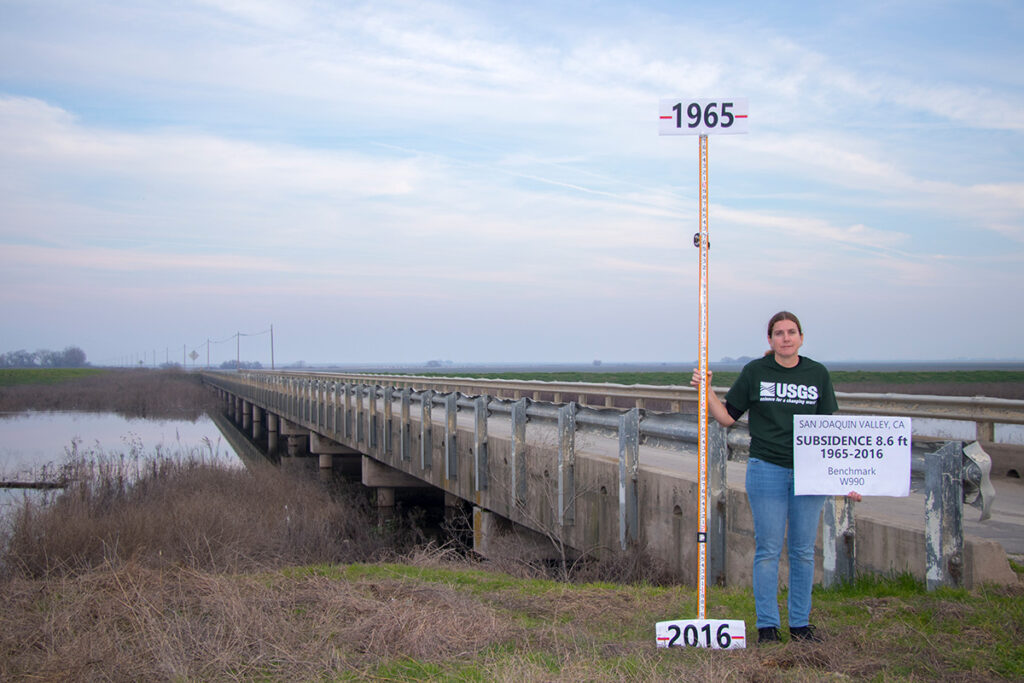Students investigate the sinking of California’s Central Valley, a phenomenon otherwise known as land subsidence. Using the phenomenon as an anchoring point, students explore California’s water crisis and its intersection with historical colonialism, groundwater mechanics, and environmental justice through an engaging, character-driven narrative. The unit begins with Jolfy, a cyborg coyote from the future, who alerts students that the Central Valley is sinking. Along the way, students meet other characters who provide key insights: historian Yoimut, hydrogeologist Carl, climate scientist Mariah, and farmworker and local council member Jaden.
Students explore the Central Valley’s transformation from a water-rich ecosystem under Indigenous stewardship to its current state, shaped by colonization, industrial agriculture, and irrigation networks. Students investigate how aquifers work, how excessive pumping and climate change deplete groundwater, and how this impacts ecosystems and frontline communities. Students also examine solutions, such as managed aquifer recharge, water conservation, and climate action. The unit fosters critical thinking and empowers students to envision sustainable solutions for their communities.

“This did a great job of piquing students’ interest and sparking opposing points of view, which created lively discussions on the topic.”
“For my students who may not engage with abstract concepts, the real-life relevance of turning waste into soil for growing plants offers a clear, meaningful goal that they can understand and feel proud to participate in.”
“The message that there are solutions to help us combat climate change and that people are working together to solve problems helped students stay in a place of curiosity; they didn’t show anxiety over the content.”
“I truly enjoyed teaching this. It has been heartwarming to see them care about other living things and the environment.”
“I have learned ways to improve my teaching, and I have been at this for 38 years. The students are gaining a deeper understanding of what climate change is: what causes climate change, and the impact of climate change on crop yield.”
“This is engaging because it uses real data about the state students live in and shows changes within their lifetime, like the rise of warehouses and trucking during the pandemic.”
“What I find interesting is that students are discussing the material outside of class time. I heard students discussing the ideas before class in the hallways and even during lunch periods.”
“This lesson brought in cultural stories from the original people who inhabited California. This is a perspective that is not often taught in science. I think that the kids liked having science be a little less facts and figures and more story.”
“Using the maps and seeing things like schools and how close they are to hazards is really cool. They may not be super connected personally, but they can put themselves in the shoes of other kids and try to relate. I know it’s working because I have a kid that just watches Netflix all day, every day and he pulled out his earbud and participated!”
“The kids become more engaged because now they are actually actively doing things. They’re really having to look for themselves. It’s not given to them on a platter, but all the resources are right there.”
“When you’re out in the workforce, you’re trying to solve problems that don’t have a clear, immediate answer. So doing stuff like this helps give students practice.”
“Every lesson was so thoroughly designed, the case study design book was beautifully organized, and it helped to give my class a real-life understanding of how college/graduate-level academic research works. Being able to connect their research back to environmental issues they actually experience was simply icing on the cake. Well done!”

Katie Cox, Global Nomads
Katinka Lennemann, Global Nomads
Sandra Stein, Global Nomads
Nour Akkoush
Lois Akundo
Shahvhir Bhujwala
Sophia da Silva Bispo
Zoe Chan
İzzet Enes Çoğan
Emily Dersch
Glenis Fernandes
Natalia Grandio
Sarah Guadagnolo
Zeynep Gül
Jahswill Kalu
Joy Kalu
Choyoung Kim
Katinka Lennemann
Rainy Lu
Confidence Maduka
Ifeanyi Maduka
Vivian Sabelo Magagula
Buhle Magushana
Ellie McCampbell
Citlalli Mora
Jonathan Kamohelo Motubatse
Simran Nagpal
Abigail Ramsayer
Khahdija Shahbaz
Sydney Shell
Fatima-Zahrae Tarib
Efsa Tirtom
Robert Tuu
Lian Wang
Maya Wu
Arjumand Zehra
Mike Antos, Stantec Consulting
Clarissa Deverel-Rico, BSCS
Jonathan Griffith. Center for Education, Engagement, and Evaluation
Thomas Herman, San Diego State University
Julie Hilborn, San Mateo County Office of Education
Elaine Klein, BSCS
Cecilia Moreno, Sierra Unified School District
Mike Muraki, Sierra College
Ryan Smith, Colorado State University
Samantha Stickley, San Marcos USD
Jonathan Traum, USGS
Mike Antos, Stantec Consulting
Dezaraye Bagalayos, Allensworth Progressive Association
Kenny Barrios, Tachi Yokut Tribe of the Santa Rosa Rancheria
Matt Ellinger, Designer
Anna Gurevitz, SocioEnvironmental and Education Network (SEEN)
Elaine Klein, BSCS
Stacey Lane, Illustrator
Ladie Malek, Development Editor
Cecilia Moreno, Sierra Unified School District
Jose Armando Munguia, TAC Farm
Steve Roderick. Concord Consortium
Ryan Smith, Colorado State University
Jonathan Traum, USGS
Brett Lackey, West Contra Costa County USD
Gabriella Isaguirre-Bersola, Los Angeles USD
Jennifer Kim, Laguna Beach USD
Marie Etherton, Southern Humboldt Joint USD
Sara Clover, Sea Crest School
Sara Brooks Long, Petaluma City Schools
Sarah Blair, East Bay Innovation Academy
Jackie Gardner, San Jacinto USD
Laureen Kuwaye, Rowland USD
You’ll get news on Seeds to Solutions and environmental literacy from Ten Strands
"*" indicates required fields
© 2025 San Mateo County Office of Education and Ten Strands | Terms of Use | Privacy Policy